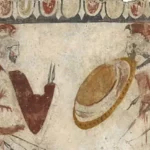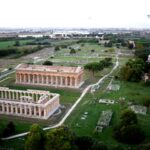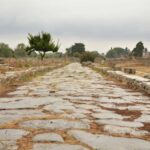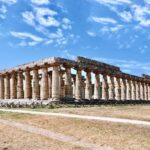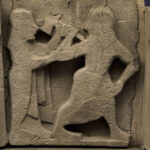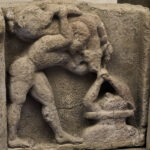Visit Paestum with an archaelogist. The most preserved greek temples in Italy
Walking tour – the tour lasts about 2 hours and 30 minutes
The history of Paestum, also known as Poseidonia in ancient times, is deeply rooted in the ancient civilizations of Magna Graecia. Here’s an overview:
Foundation: Paestum was founded by Greek colonists from the city of Sybaris around the late 7th century BC. They established the city as a trading post on the coast of southern Italy, strategically located between the Greek colonies of Cumae and Metapontum.
Greek Colony: The Greek settlers named the city Poseidonia in honor of the god Poseidon, indicating its maritime connections and importance as a port city. The city flourished as a center of Greek culture and commerce, boasting impressive temples, public buildings, and a thriving agricultural economy.
Lucanian and Roman Period: In the 5th century BC, Poseidonia came under the control of the Lucanians, an indigenous Italic tribe. During this time, the city experienced a period of decline, but its temples and infrastructure remained largely intact. In 273 BC, Rome established a colony of Latin law there and the city became Paestum. Relations between Pestani and Romans are always close and trusted, so much so that the ancient polis beats its own currency and prospered in the economy while absorbing the new Roman urban reorganization.
Abandonment and Rediscovery: Following the fall of the Western Roman Empire, Paestum gradually declined in importance, and its population dwindled. The city was eventually abandoned and fell into ruin. It remained largely forgotten until the 18th century when it was rediscovered by European travelers and scholars during the Grand Tour.
Excavation and Preservation: Excavations of Paestum began in the 18th century and have continued to the present day, revealing a wealth of archaeological treasures, including three remarkably well-preserved Greek temples dedicated to Hera, Athena, and Poseidon. These temples are among the best-preserved examples of Greek architecture in the world and are designated as UNESCO World Heritage Sites.
Cultural Significance: Paestum holds immense cultural significance as one of the most important archaeological sites in Italy. Its well-preserved temples and artifacts offer valuable insights into ancient Greek and Roman civilization, including architecture, religion, art, and daily life. The site attracts thousands of visitors each year who come to marvel at its beauty and historical significance
The Temple of Neptune (also known as the Temple of Poseidon) is considered one of the most important monuments of the classical era of Greek civilization. More information about this impressive temple:
Architecture: The Temple of Neptune was constructed around 450 BC, during the Greek colonization of the area. It is a classic example of Doric architecture, characterized by its simple and elegant design. The temple is peripteral, meaning it is surrounded by columns on all sides, and it features a pronaos (front porch), cella (inner chamber), and opisthodomos (rear porch).
Dimensions: The temple measures approximately 60 meters (197 feet) in length and 24 meters (79 feet) in width, making it one of the largest temples in the Greek world. Its massive size and well-preserved condition make it an impressive sight for visitors to Paestum.
Construction Materials: Like the other temples at Paestum, the Temple of Neptune was constructed using local limestone blocks, which were carefully cut and stacked to create the temple’s imposing façade. The columns are made of sturdy Doric marble, with fluted shafts and simple capitals.
Decoration: While much of the original decoration of the Temple of Neptune has been lost over time, traces of its colorful painted decoration can still be seen on the remaining architectural elements. Like many ancient Greek temples, it would have been adorned with painted sculptures, friezes, and architectural details.
Religious Significance: The Temple of Neptune was dedicated to the Greek god of the sea, Poseidon (Neptune in Roman mythology). It served as a place of worship where ancient Greeks would make offerings and sacrifices to honor the god and seek his protection for sailors and seafarers.
Preservation: Despite centuries of earthquakes, looting, and neglect, the Temple of Neptune has survived remarkably well. Its sturdy construction and remote location contributed to its preservation, and extensive restoration efforts have helped to stabilize the structure and prevent further deterioration.
Visitor Experience: Today, the Temple of Neptune is a popular tourist attraction within the Paestum archaeological site. Visitors can explore the temple’s interior and admire its imposing columns and architectural details. The temple offers a fascinating glimpse into the religious and architectural practices of ancient Greece and is a testament to the enduring legacy of classical civilization in Italy.
Overall, the history of Paestum reflects the dynamic interactions between Greek, Italic, and Roman cultures in ancient Italy, as well as the enduring legacy of classical civilization in the Mediterranean region. Today, Paestum stands as a testament to the ingenuity and creativity of its ancient inhabitants and serves as a reminder of the rich cultural heritage of Magna Graecia.
WHAT’S INCLUDED
- Guiding Service
ITINERARY
– The tour includes a visit to the ancient city of Paestum, where you will also visit the Roman period of the ancient city of Greek foundation.
We’ll visit:
– The so called Basilica, the temple of Neptune, the temple of Ceres, a tomb (Greek period). (1 hour and 30 minutes in total)
– The forum, the streets, the arena, a sacred swimming pool, some houses (Roman period).
– The local museum: Greek and Lucan art. (1 hour)
– The local museum: Greek and Lucan art. (1 hour)
*This tour can be customized
ESTIMATED LOCAL CASH NEEDED
10 € – admission fees to enter in Paestum (the price is per person).
Under 18 years old are free of charge.


